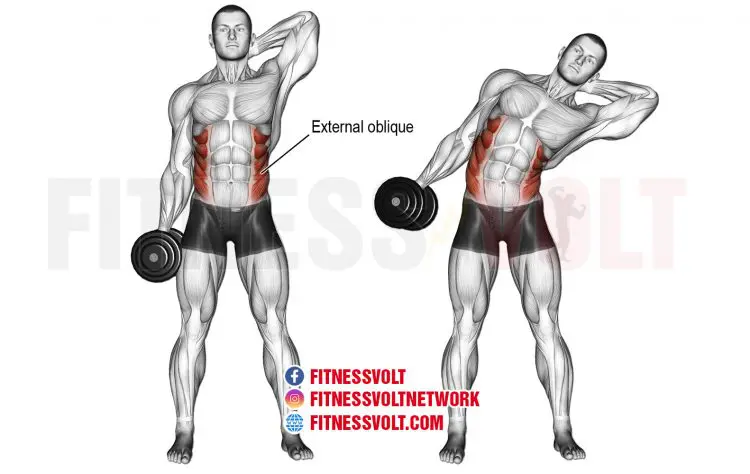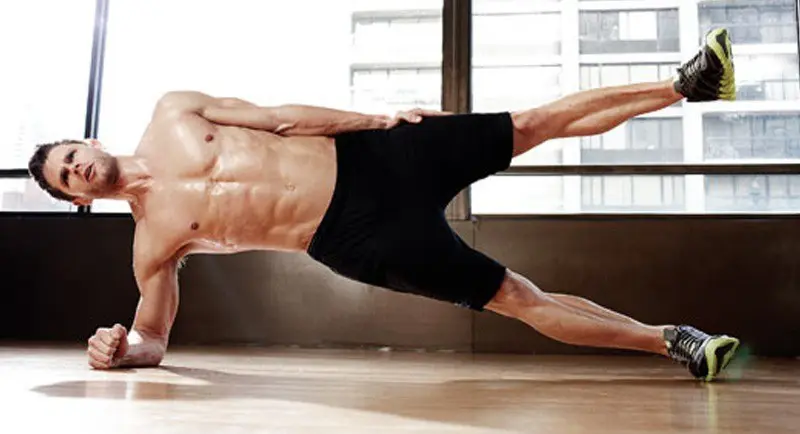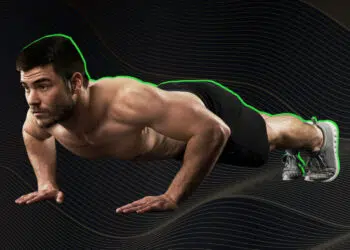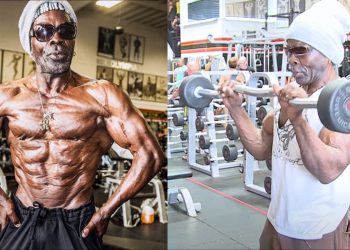When it comes to abs training, a lot of people focus almost exclusively on the muscle at the front of their abdomen; the rectus abdominis. In some ways, this makes a lot of sense because that’s the muscle that gives you a six-pack – providing you are lean enough to see it, of course!
However, there is more to a well-develop midsection than your rectus abdominus. Oblique or side crunches train the muscles of your waist, which are every bit as important.
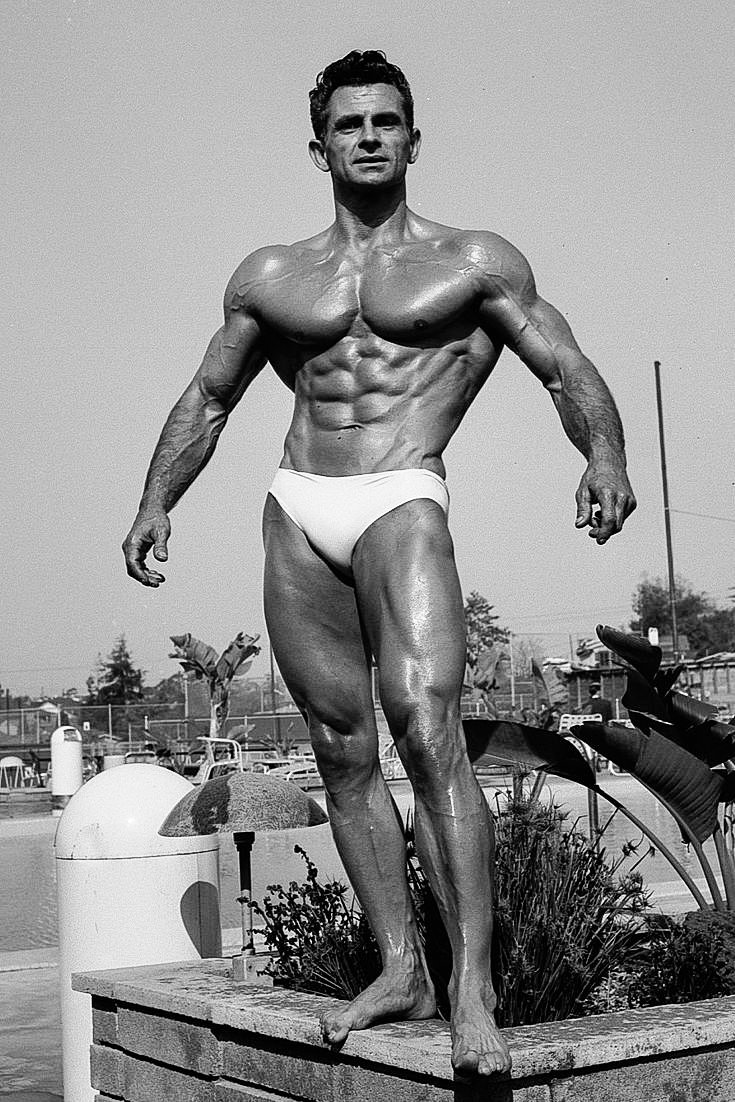
In this article, we explain why and how to do this exercise and provide you with several variations and alternatives to try.
Oblique Crunches Muscles Worked
You probably won’t be surprised to learn that oblique crunches work your obliques! However, there are some other muscles involved in this exercise:
Internal and external obliques – the internal and external obliques run diagonally across your midsection and are responsible for rotating and laterally flexing your spine. The internal obliques lie beneath the external obliques. Both oblique muscles work together and are basically your waist muscles.
Level Up Your Fitness: Join our 💪 strong community in Fitness Volt Newsletter. Get daily inspiration, expert-backed workouts, nutrition tips, the latest in strength sports, and the support you need to reach your goals. Subscribe for free!
Rectus abdominis – usually just called the abs for short, this long, flat muscle runs from your sternum and lower ribs down to the bottom of your pelvis. While the primary function of your rectus abdominis is flexion of your spine, it also works with your obliques in lateral flexion.
Quadratus lumborum – running from your lowermost ribs to the top of your pelvis, this deep muscle helps your abs and obliques flex your spine laterally.
Transverse abdominis – where the rectus abdominis runs vertically up the front of your stomach, the transverse abdominis encircles it like a muscular weightlifting belt. Situated beneath the other muscles, the TVA contracts inward to stabilize your spine. Increase TVA activation by breathing out forcefully as you contract your abs and obliques.
How To Do Oblique Crunches
Get the most from oblique crunches while keeping your injury risk to a minimum by following these step-by-step instructions:
- Lie on your left side with your hips square, and your legs bent. Place your left hand on the right side of your waist to provide feedback from the muscles you are working on. Put your right hand on the side of your head.
- Use your uppermost obliques to flex your torso and draw your right shoulder down toward your hip. Move slowly and deliberately, contracting your obliques as hard as you can.
- Pause at the top of each rep for 2-3 seconds, lie back down, and repeat.
- Roll over and do the same number of reps on the opposite side.
Oblique Crunches Benefits and Drawbacks
Benefits
Oblique or side crunches are a useful abs exercise with several notable benefits:
No equipment required – while weighted abs exercises like cable crunches and dumbbell side bends are equally effective, you need access to equipment to do them. Oblique crunches require just your bodyweight and somewhere to lie down, so they’re ideal for home exercisers.
Target your obliques – while side crunches also work your rectus abdominis, the prime mover is your obliques. Well-developed obliques can add a lot to the appearance and function of your midsection, and adding this exercise to your workout program will help you sculpt an even better-looking core.
Easy to learn – oblique crunches are a pretty straightforward exercise that’s easy to master. It’s a useful movement for beginners but, done slowly and deliberately, is also suitable for more advanced exercisers.
Drawbacks
While oblique crunches are mostly beneficial, there are a few drawbacks to consider too:
Limited overload – the range of movement and load involved in this exercise means that oblique crunches are not all that hard, and the only way to make them more challenging is to do more reps. High rep abs training is not very time-efficient and won’t do much to increase the strength of your obliques.
Some people just don’t feel this exercise – done correctly, oblique crunches are an effective abs exercise. That said, some people report not really feeling this exercise and find it ineffectual. A strong mind-muscle link is often the difference between success and failure when doing this exercise.
Level Up Your Fitness: Join our 💪 strong community in Fitness Volt Newsletter. Get daily inspiration, expert-backed workouts, nutrition tips, the latest in strength sports, and the support you need to reach your goals. Subscribe for free!
7 Oblique Crunch Variations and Alternatives
While oblique crunches are a popular and effective exercise, if that’s all you ever do for your waist, this exercise will soon lose some of its potency. Keep your core workouts fresh, interesting, and productive with these oblique crunch variations and alternatives.
1. Stability ball oblique crunch
Abs exercises using a stability ball are generally more challenging than the same exercise done on the floor. Using a ball increases your range of motion and causes instability, leading to greater muscle fiber recruitment.
How to do it:
- Lie on your side on a stability ball, so the ball is in the curve of your waist. Brace your feet against the base of a wall for balance.
- Keeping your hips and shoulders square, wrap your upper body around the curve of the ball, and then use your obliques to curl your uppermost shoulder toward your hip.
- Extend your body back over the ball and repeat.
- The higher you raise your arms, the longer the lever becomes, and the harder this exercise will be. You can also do this exercise while holding a weight plate or dumbbell to your chest.
2. Dumbbell side bend
The main advantage of dumbbell side bends over oblique crunches is that you can use progressively heavier weights to make them more challenging. However, it is crucial you don’t hold a dumbbell in each hand in an attempt to train both sides of your waist at once. One weight counterbalances the other, turning what should be a good oblique exercise into more of a forearm workout!
How to do it:
- Hold a dumbbell in one hand and stand with your feet about shoulder-width apart. Brace your abs, and make sure your shoulders and hips are square.
- Lean to the side and lower the weight down the outside of your leg. Go as far as your flexibility allows. Do not twist your shoulders or hips.
- Using your obliques and abs, return to the upright position and crunch over to the other side to fully contract the target muscles.
- Lower the weight down your leg again and repeat.
- You can also do this exercise using a low cable machine and a single D-shaped handle.
3. Oblique cable crunch
If you have mastered the side crunch, the oblique cable crunch is an excellent next choice. Done kneeling or standing, using a cable machine allows you to use more weight and keeps your muscles under constant tension. As with regular side crunches, really flex your obliques hard to maximize the effect of this exercise.
Learn how to do this exercise here.
4. Single-arm farmer’s walk
While the single-arm farmer’s walk looks nothing like a side crunch, it’s actually a very effective oblique exercise. During single-arm farmer’s walks, you’ll need to use your obliques to keep your torso upright.
You are stronger isometrically than you are concentrically or eccentrically, which means you can go really heavy on this exercise, giving your obliques a serious strength-building workout.
How to do it:
- Hold a heavy dumbbell or kettlebell in one hand, arm down by your side. Brace your abs to keep your torso perfectly upright.
- Walk around your training area until your grip starts to fail, or you cannot stay upright.
- Switch hands and repeat.
5. Side plank leg lift
Side planks provide your obliques with a good workout, but, like most bodyweight abs exercises, all too soon, they will lose some of their effect, and you’ll need to do them for longer and longer. This side plank variation involves a leg raise which makes them more challenging. You can also do this exercise for reps instead of a predetermined time.
How to do it:
- Lie on your side with your body straight and resting on your bent arm. With your legs together, raise your hips up, so your weight is supported on your lowermost foot and arm only. Brace your abs.
- Without raising or lowering your hips, lift your uppermost leg until your foot is toughly level with your shoulder.
- Lower your leg and repeat.
- Swap sides and do the same number of reps with the other leg.
6. Suitcase deadlift
Love deadlifts? Want to hammer your obliques? Then suitcase deadlift is the exercise for you. It involves bracing your abs and using your obliques to maintain an upright torso while doing single-arm deadlifts. It’s a very functional exercise that’s ideal for building full-body strength and stability. The name comes from how this exercise makes you look like you are bending down to pick up a bag or suitcase.
How to do it:
- Set up your barbell, so it’s roughly mid-shin height. You can also use a single dumbbell or a kettlebell. Stand sideways to your weight.
- Without leaning sideways, feet shoulder-width apart, squat down and grab the weight with your nearest hand. Drop your hips, lift your chest, brace your core, and look straight ahead.
- Drive your feet into the floor and stand up, ensuring you do not lean toward or away from the weight.
- Lower the weight back to the floor and repeat.
- Rest a moment and then do the same number of reps on the opposite side.
7. Landmine full contact twists
As well as laterally flexing your spine, your obliques are the muscles responsible for spinal rotation. Exercises like cable wood chops, twisting crunches, and Russian twists are all useful oblique exercises. However, for an even more powerful oblique exercise, give landmine full contact twists a try.
This exercise not only works your waist but also trains your arms and shoulders. Oblique exercises don’t come much more functional than this! No landmine? No problem; just use a standard Olympic bar with one end wedged in a corner.
How to do it:
- Lift the bar and hold it above your head with your hands close together, both palms facing inward. Brace your core and pull your shoulders down and back. Press the bar forward and down
- Maintaining core tension, turn your shoulders and arms and lower the landmine bar down to one side. Turn your hips in the same direction as your arms.
- Raise the weight back up and then repeat on the opposite side.
- Continue alternating sides for the duration of your set, pushing your arms forward and down the entire time.
Oblique Crunches – Wrapping Up
You don’t see a lot of people doing oblique crunches anymore. A lot of trainers and exercisers think that working the obliques will lead to a wide, blocky waist, but that’s simply not true. In fact, working your obliques will contribute to the V-shaped torso that so many exercisers want.
There are lots of exercises you can use to target your obliques, but the side crunch is as good as any. It’s easy to learn, you can do it anywhere, and if you do them slowly and deliberately, contracting your obliques hard at the top of each rep, they’re very effective.
The rectus abdominis might be the most famous abs muscle, but your obliques deserve some love too. Work them without equipment by doing oblique crunches.
Interested in measuring your progress? Check out our strength standards for Cable Crunch, Deadlift, Side Crunch, and more.

